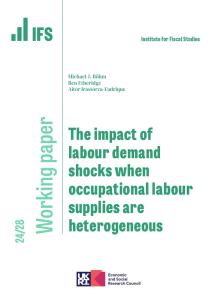Downloads

Download working paper here
PDF | 1.22 MB
This paper proposes an empirical approach to decompose the distributional effects of minimum wages into effects for workers moving out of employment, workers moving into employment, and workers continuing in employment. We estimate the effects of the minimum wage on the hazard rate for wages, which provides a convenient way of re-scaling the wage distribution to control for possible employment effects. We nd that minimum wage increases do not result in an abnormal concentration of Job Leavers below the new minimum wage, which is inconsistent with employment effects predicted by a neoclassical model. We also find that, for Job Stayers, the spike and spillover effects of the minimum wage are simply shifted right to the new minimum wage. Our findings are consistent with a model where entry wages are set according to a job ladder, and where firms preserve their internal wage structure due to fairness or internal incentives issues.
Authors

Pierre Brochu

Research Fellow University of British Colombia
David is a Research Fellow of the IFS and a Professor at the University of British Columbia.
September to December 2024

James Townsend
Professor of Economics University of British Colombia
Working Paper details
- DOI
- 10.1920/wp.ifs.2023.3223
- Publisher
- Institute for Fiscal Studies
Suggested citation
Brochu, P et al. (2023). The minimum wages, turnover, and the shape of the wage distribution. 23/32. London: Institute for Fiscal Studies. Available at: https://ifs.org.uk/publications/minimum-wages-turnover-and-shape-wage-distribution (accessed: 30 June 2024).
More from IFS
Understand this issue

Big firm, little firm: are differences between companies driving inequality and holding back growth?
30 August 2023

Don’t cheer end of earnings squeeze: there is more pain to come
19 June 2023

The economics of immigration
8 June 2023
Policy analysis

How do the last five years measure up on levelling up?
19 June 2024

The Conservatives and the Economy, 2010–24
3 June 2024

A decade and a half of historically poor growth has taken its toll
3 June 2024
Academic research

Labour market inequality and the changing life cycle profile of male and female wages
15 April 2024

The impact of labour demand shocks when occupational labour supplies are heterogeneous
28 June 2024

Social skills and the individual wage growth of less educated workers
27 March 2024